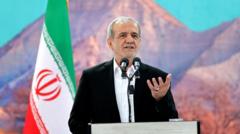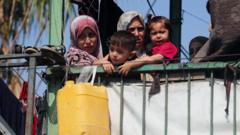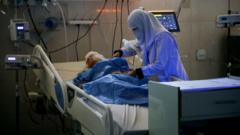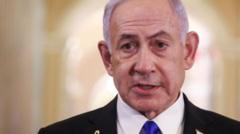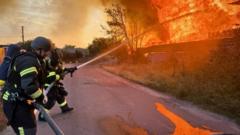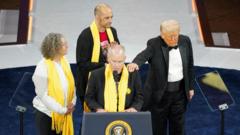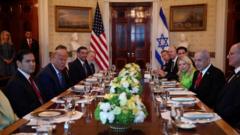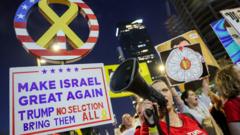Schools in Beirut's southern suburb of Dahieh are now bracing themselves for a potential return to war following recent Israeli airstrikes identified as targeting Hezbollah facilities. The situation has led to increased chaos and fear among parents and students, highlighting the trauma of previous conflicts and their lasting impact on the community.
Return of Israeli Strikes Triggers Fear of War in Beirut's Schools

Return of Israeli Strikes Triggers Fear of War in Beirut's Schools
Recent IDF airstrikes in a Beirut suburb renew anxiety over the possibility of an escalating conflict.
Despite the ceasefire that was established last November, recent activities suggest that the region is still vulnerable to violence as residents witness the destruction wrought by earlier airstrikes.
In the typically lively atmosphere of Dahieh, a Friday afternoon transformed into panic when an urgent warning from the Israel Defense Forces (IDF) went viral, alerting residents to an imminent airstrike on a Hezbollah facility situated close to schools. The area had been relatively calm, having emerged from a war that had ravaged it just months earlier, yet the IDF’s instructions immediately sent parents rushing to collect their children while residents fled in terror.
Ahmad Alama, director of St Georges School, recalled the chaos: "We tried to contain the situation as much as we could, but it was crazy." The incident, which resulted in the destruction of a Hezbollah-linked building, has reignited fears of a return to the all-out war that many believed had ended following a ceasefire last November.
Israeli forces maintained that the airstrikes were necessary to prevent Hezbollah from rearming, with prior attacks having escalated since violence flared up in October 2023. The community is now on high alert, as schools implement evacuation drills and communication plans to ensure that such chaos doesn’t repeat itself.
Yet underlying issues persist; psychological trauma from the recent conflicts weighs heavily on students and staff, prompting educators like Mr. Alama to increase extracurricular activities to support pupils amidst the ongoing fear. The visible damage in the area is a constant reminder of the past, with many buildings still in ruins, and while shops have reopened, the scars of destruction linger palpably.
Sawsan Hariri, a headteacher at Burj High School, shared the emotional toll: "I see the destroyed buildings and I cry." The school community has dwindled dramatically as parents remain hesitant to send their children back to a disrupted learning environment, and the pervasive dust and noise of recovery efforts contribute to an atmosphere of distress and uncertainty.
Despite promises from Hezbollah and the Lebanese government to assist those displaced by the conflict, much remains to be done, and the path to recovery feels uncertain, with extensive rebuilding efforts projected far beyond the horizon. International demands for political reforms and Hezbollah's disarmament complicate the prospects for future stability and support.
As the residents of Dahieh navigate this fraught landscape of grief and resilience, the specter of war looms large once more, reminding the community that peace, though desired, remains fragile.
In the typically lively atmosphere of Dahieh, a Friday afternoon transformed into panic when an urgent warning from the Israel Defense Forces (IDF) went viral, alerting residents to an imminent airstrike on a Hezbollah facility situated close to schools. The area had been relatively calm, having emerged from a war that had ravaged it just months earlier, yet the IDF’s instructions immediately sent parents rushing to collect their children while residents fled in terror.
Ahmad Alama, director of St Georges School, recalled the chaos: "We tried to contain the situation as much as we could, but it was crazy." The incident, which resulted in the destruction of a Hezbollah-linked building, has reignited fears of a return to the all-out war that many believed had ended following a ceasefire last November.
Israeli forces maintained that the airstrikes were necessary to prevent Hezbollah from rearming, with prior attacks having escalated since violence flared up in October 2023. The community is now on high alert, as schools implement evacuation drills and communication plans to ensure that such chaos doesn’t repeat itself.
Yet underlying issues persist; psychological trauma from the recent conflicts weighs heavily on students and staff, prompting educators like Mr. Alama to increase extracurricular activities to support pupils amidst the ongoing fear. The visible damage in the area is a constant reminder of the past, with many buildings still in ruins, and while shops have reopened, the scars of destruction linger palpably.
Sawsan Hariri, a headteacher at Burj High School, shared the emotional toll: "I see the destroyed buildings and I cry." The school community has dwindled dramatically as parents remain hesitant to send their children back to a disrupted learning environment, and the pervasive dust and noise of recovery efforts contribute to an atmosphere of distress and uncertainty.
Despite promises from Hezbollah and the Lebanese government to assist those displaced by the conflict, much remains to be done, and the path to recovery feels uncertain, with extensive rebuilding efforts projected far beyond the horizon. International demands for political reforms and Hezbollah's disarmament complicate the prospects for future stability and support.
As the residents of Dahieh navigate this fraught landscape of grief and resilience, the specter of war looms large once more, reminding the community that peace, though desired, remains fragile.

